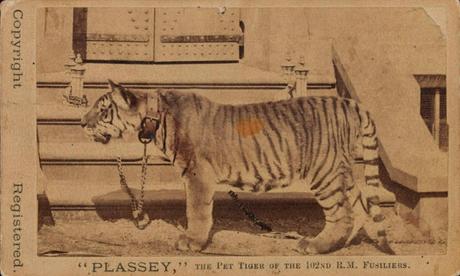 The regimental pet of the
102nd Regiment of Foot (Royal
Madras Fusiliers) was a Bengal tiger cub called
'Plassey'. He was named after Robert Clive's famous victory of 1757,
which was also a battle honor of the Madras Fusiliers. Indeed, the cap badge
of their regiment also depicted a tiger, a beast much respected for its
strength, grace and power. 'Plassey' was one of a pair of tigers captured by
Captain Frank Thackwell of the 5th Lancers, and presented by him to the Madras
Fusiliers. Legend has it that 'Plassey' was fairly tame and even on friendly
terms with the other regimental pets in India, an antelope and a dog. In 1868,
after 233 years of Indian service, the 102nd were shipped to England for the first time.
'Plassey' came with them and was certainly well behaved on the voyage home from
India, when he was in the company of two young leopards. On arrival, he lived
unchained with the garrison at Dover, but apparently alarmed the local
inhabitants on several occasions. He was reluctantly sent to the local
zoological gardens, where he eventually died. The photo here is owned by :
National Army Museum UK (https://collection.nam.ac.uk/detail.php?acc=1964-08-341-2)
Now if you remember the
name still, G. Konduru (Gaddamanugu Konduru) is a
village in Krishna district of Andhra Pradesh.
The Battle of Condore took place near Masulipatam on 9 December 1758
during the Third Carnatic War, part of the Seven Years' War. An Anglo-Indian
force under the command of Colonel Francis Forde attacked and defeated a
similarly sized French force under the command of Hubert de Brienne, Comte de
Conflans, capturing all their baggage and artillery. The victory allowed the
British to lay siege to Masulipatam, which they stormed on 25 January 1759.
It is
recorded that in Sept 1758, Bussy, commanding a French corps in Deccan, was
recalled with his troop to reinforce Lally and support him for the siege of
Madras. The only French military presence in this region now consisted of a
very small corps under M. de Conflans occupying the Northern Circars. A local rajah revolted against the French. Clive
sent 2,600 men under lieutenant-colonel Forde in an expedition against Deccan. In Dec - Forde's and Conflans' army faced
each other on the road leading south to Rajahmundry. To break the plan of French, Forde, made a detour of 5 km to Condore with his own
troops met the rajah's troops in full flight and rallied them, after which the
whole force pursued its march and at 8:00 am arrived at Condore.
Conflans,
thinking that he had defeated Forde's entire army, followed him quickly, as soon as the British forces had occupied
Condore, the French army appeared 1 km in their rear moving towards Forde's
left flank. Natural to deduct that Indians died in hundreds fighting for
both the rivals, which would remain unaccounted, unheralded and not properly
recorded too.
With regards – S.
Sampathkumar
The regimental pet of the
102nd Regiment of Foot (Royal
Madras Fusiliers) was a Bengal tiger cub called
'Plassey'. He was named after Robert Clive's famous victory of 1757,
which was also a battle honor of the Madras Fusiliers. Indeed, the cap badge
of their regiment also depicted a tiger, a beast much respected for its
strength, grace and power. 'Plassey' was one of a pair of tigers captured by
Captain Frank Thackwell of the 5th Lancers, and presented by him to the Madras
Fusiliers. Legend has it that 'Plassey' was fairly tame and even on friendly
terms with the other regimental pets in India, an antelope and a dog. In 1868,
after 233 years of Indian service, the 102nd were shipped to England for the first time.
'Plassey' came with them and was certainly well behaved on the voyage home from
India, when he was in the company of two young leopards. On arrival, he lived
unchained with the garrison at Dover, but apparently alarmed the local
inhabitants on several occasions. He was reluctantly sent to the local
zoological gardens, where he eventually died. The photo here is owned by :
National Army Museum UK (https://collection.nam.ac.uk/detail.php?acc=1964-08-341-2)
Now if you remember the
name still, G. Konduru (Gaddamanugu Konduru) is a
village in Krishna district of Andhra Pradesh.
The Battle of Condore took place near Masulipatam on 9 December 1758
during the Third Carnatic War, part of the Seven Years' War. An Anglo-Indian
force under the command of Colonel Francis Forde attacked and defeated a
similarly sized French force under the command of Hubert de Brienne, Comte de
Conflans, capturing all their baggage and artillery. The victory allowed the
British to lay siege to Masulipatam, which they stormed on 25 January 1759.
It is
recorded that in Sept 1758, Bussy, commanding a French corps in Deccan, was
recalled with his troop to reinforce Lally and support him for the siege of
Madras. The only French military presence in this region now consisted of a
very small corps under M. de Conflans occupying the Northern Circars. A local rajah revolted against the French. Clive
sent 2,600 men under lieutenant-colonel Forde in an expedition against Deccan. In Dec - Forde's and Conflans' army faced
each other on the road leading south to Rajahmundry. To break the plan of French, Forde, made a detour of 5 km to Condore with his own
troops met the rajah's troops in full flight and rallied them, after which the
whole force pursued its march and at 8:00 am arrived at Condore.
Conflans,
thinking that he had defeated Forde's entire army, followed him quickly, as soon as the British forces had occupied
Condore, the French army appeared 1 km in their rear moving towards Forde's
left flank. Natural to deduct that Indians died in hundreds fighting for
both the rivals, which would remain unaccounted, unheralded and not properly
recorded too.
With regards – S.
Sampathkumar
1st Jan 2018.

